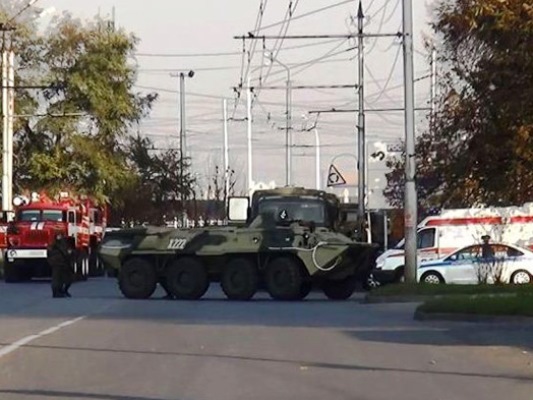
Security Forces Reportedly Kill 11 Rebels in Kabardino-Balkaria
Publication: Eurasia Daily Monitor Volume: 12 Issue: 216
By:

Kabardino-Balkarian jamaat has regained little of its strength since its leader, Amir Abdullah (Robert Zankishiev), was killed in a police operation in Nalchik on November 10 (TASS, November 10). In fact, the jamaat has suffered new, even more substantial losses. On November 22, the authorities introduced a counterterrorist operation regime in Nalchik’s suburbs and the adjacent Cherek district (Interfax, November 22). The security services had reportedly “received information about the presence of a group of armed individuals in the forested foothills area around Nalchik” (Kavkazsky Uzel, November 22).
Special units of the Federal Security Service (FSB), reinforced by local police, were dispatched to deal with the militants. According to government sources, when the police and the security services called on the surrounded rebels to surrender, the rebels started shooting chaotically and threw several hand grenades. The FSB special units attacked the rebels, and the clash lasted for several hours. Since the government forces sealed off the area, no militants had a chance to escape. The government declared later in the afternoon on November 22 that 11 rebels were killed (Rosbalt, November 22).
Even though it appears the FSB was quite lucky to carry out such an operation outside an urban environment, in an area where civilians could not have been harmed, there are also some questions about this operation. The militants of the jamaat of Kabarda, Balkaria and Karachay (KBK) have normally resided within the city limits. They would go to the mountains and forests only to set up hideouts and hold large meetings away from surveillance by the security services. It is unclear why 11 militants met in one spot in November without taking precautions like posting lookouts, so that the security forces were able to kill them inside their hideout. The most likely explanation is that the FSB had managed to plant a mole in the ranks of the KBK jamaat. In fact, law enforcement officials admitted that they found the rebels’ hideout near the Khasanya-Gerpegezh-Kashkhatau highway more than two weeks ago (Kavkazsky Uzel, November 24). This means that the security services managed to lure as many militants as possible to one place so that they could kill them all at once. Some of the slain rebels have been identified as 22-year-old Anzor Tengizov, 24-year-old Vladimir Tengizov, 22-year-old Arsen Belimgotov, 27-year-old Artur Shakov, 29-year-old Sergei Akshaev and 24-year-old Dmitry Liev. The young age of the slain militants clearly stands out.
What has happened to the KBK jamaat is quite similar to the fate of the Ingush jamaat: the authorities captured the Ingush jamaat’s leader, Amir Magas in 2010, and within six months virtually eliminated the jamaat’s entire core.
The special operation in Nalchik cannot simply be attributed to the Russian security services’ good luck, but rather to their sustained efforts to dismantle the insurgency in Kabardino-Balkaria. On the same day, November 22, the Russian media unexpectedly announced that the authorities had introduced another counterterrorism operation regime in the republic. That evening, an armed clash broke out in downtown Nalchik in which three rebels were reported dead, including Yury Bitsuev, who was said to be the successor of the leader of the KBK jamaat, Robert Zankishiev, who was killed on November 10. The authorities claimed they confiscated a large cache of weapons from the slain militants. According to the police, the three militants attempted to escape after their associates were killed near Nalchik (Grani.ru, November 22). Two residents of Nalchik, 29-year-old Murat Zhamborov and 30-year-old Murat Tarchokov, were killed alongside the presumed new KBK jamaat amir (Kavkazsky Uzel, November 23).
Given the current policies of Russia in the region, the government predictably identified all slain militants in Kabardino-Balkaria as members of the so-called Islamic State. The authorities alleged the slain rebels had recruited militants for the Islamic State in Syria, which is quite dubious since the local insurgents evidently do not have many recruits themselves and would rather replenish their own ranks. Members of the KBK jamaat itself also raised doubts about their allegiance to the Islamic State. Their website said that even though Robert Zankishiev (Amir Abdullah) pledged allegiance to Islamic State leader Abu Bakr al-Baghadadi, it is unclear if the local amirs supported his decision. The insurgents’ website also said that the slain Yuri Bitsuev was not the new leader of the jamaat, but the amir of the Central Sector of the Velayat of Kabarda, Balkaria and Karachay in the Caucasus Emirate, not the Caucasus branch of the Islamic State (Islamdin.com, November 22).
This clarification is interesting, because it indicates that not all the rebels in Kabardino-Balkaria followed the orders of their previous leader, Amir Abdullah. Moreover, the website of Kabardino-Balkaria’s insurgents has raised doubts about the legitimacy of Amir Abdullah, which suggests that he may have been deposed after he took the pledge of allegiance to the Islamic State, because the bulk of the insurgents in the republic remained loyal to the Caucasus Emirate. This does not change much, but it does show the high degree of uncertainty in the ranks of the local armed Islamic underground movement in Kabardino-Balkaria.
In any case, the loss of 14 insurgents in one day is a powerful blow that will weaken the local jamaat for a long time. The death of their amir and their Central Sector’s amir are bad omens for the rebels of Kabardino-Balkaria, which show gaps in their system of security. For the time being, they will likely have go deep underground, as the rebels in Ingushetia and Karachaevo-Cherkessia did before they become an effective force again. This does not mean that the insurgency in Kabardino-Balkaria is finished, but its activities will plummet in the republic for some time.




